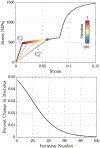Beyond Constant Curvature: A New Mechanics Model for Unidirectional Notched-Tube Continuum Wrists
- PMID: 36017195
- PMCID: PMC9400950
- DOI: 10.1142/s2424905x21400043
Beyond Constant Curvature: A New Mechanics Model for Unidirectional Notched-Tube Continuum Wrists
Abstract
This paper presents a new mechanics model for unidirectional notched-tube continuum wrists, a class of mechanisms frequently used to implement distal steering in needle-sized surgical robotic instruments. Existing kinematic models available for these devices are based on the simplifying assumption that, during actuation, all the notches undergo the same amount of deflection, so that the shape of a wrist can be approximated by an arc of constant curvature. This approach is analytically attractive, but, as we show in this paper, it can sometimes fail to provide good tracking accuracy. In this article, we provide a new model that relaxes the assumption above, and we report experimental evidence showing its superior accuracy. We model wrist deflection using Castigliano's second theorem, with the addition of a capstan friction term that accounts for frictional losses on the actuation tendon. Because notched-tube wrists are typically made of Nickel-Titanium (Nitinol), which has nonlinear stress-strain characteristics, we use a technique to obtain a local linearized approximation of the material modulus, suitable for use in the deflection model. The result of our modeling is a system of nonlinear equations that can be solved numerically to predict the wrist configuration based on the applied actuation force. Experimental results on physical specimens show that this improved model provides a more accurate estimate of wrist kinematics than prior models assuming constant curvature bending.
Keywords: Notched-tube Joints; Steerable Needles; Surgical Robotics.
Figures












References
-
- Choi D, Kim SH, Lee W, Kang S and Kim K, Development and preclinical trials of a surgical robot system for endoscopic endonasal transsphenoidal surgery, International Journal of Control, Automation and Systems 19(3) (2021) 1352–1362.
-
- Kim J, Looi T, Newman A and Drake J, Development of deployable bending wrist for minimally invasive laparoscopic endoscope, 2020 IEEE/RSJ International Conference on Intelligent Robots and Systems (IROS), (2020), pp. 3048–3054.
-
- Amanov E, Ropella DS, Nimmagadda N, Ertop TE, Mitchell JE, Kavoussi NL, Hendrick RJ, Dillon N, Blum E, Herrell SD et al., Transurethral anastomosis after transurethral radical prostatectomy: A phantom study on intraluminal suturing with concentric tube robots, IEEE transactions on medical robotics and bionics 2(4) (2020) 578–581. - PMC - PubMed
-
- Gafford JB, Webster S, Dillon N, Blum E, Hendrick R, Maldonado F, Gillaspie EA, Rickman OB, Herrell SD and Webster RJ, A concentric tube robot system for rigid bronchoscopy: a feasibility study on central airway obstruction removal, Annals of biomedical engineering 48(1) (2020) 181–191. - PMC - PubMed
Grants and funding
LinkOut - more resources
Full Text Sources
